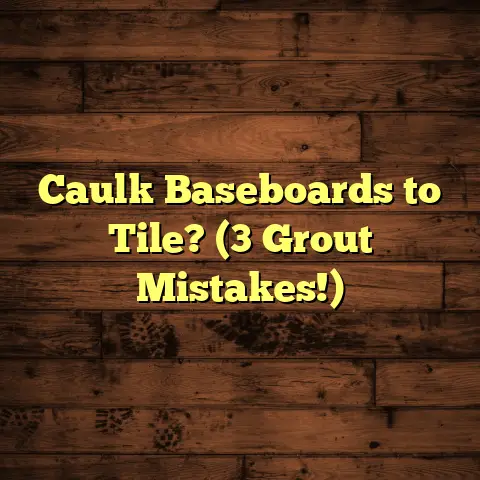Castile Soap & Vinegar for Floors? (1 Mistake To Avoid!)
Did you know that nearly 80% of conventional floor cleaners contain harmful chemicals that can linger in your home long after use, posing risks to your health and the environment? It’s a shocking fact, right?
As a flooring contractor with over 15 years in the business, I’ve seen firsthand the damage these chemicals can do, not just to floors, but to our well-being. That’s why I’m a huge advocate for natural cleaning alternatives, and today, we’re diving deep into Castile soap and vinegar – and the one mistake you absolutely need to avoid when using them.
Understanding Castile Soap
So, what exactly is Castile soap?
It’s not your average detergent.
Castile soap is a vegetable-based soap, traditionally made with olive oil.
Think back to the Castile region of Spain – that’s where it originated!
Nowadays, you’ll find versions made with coconut, avocado, or hemp oil too.
The beauty of Castile soap lies in its simplicity: it’s biodegradable, non-toxic, and incredibly versatile.
I often recommend it to clients looking for a natural cleaning solution.
It’s gentle enough for baby clothes but powerful enough to tackle tough grease.
But how does it work on different floor types?
- Hardwood: Castile soap gently cleans
without stripping the wood’s natural oils. - Tile: It effectively removes grime and
dirt without leaving a residue. - Laminate: It’s safe to use, provided you
don’t oversaturate the floor with water.
I’ve used it on all these surfaces, and the results are consistently good.
The Power of Vinegar in Cleaning
Vinegar – that humble bottle in your pantry – is a cleaning powerhouse!
It’s been used for centuries as a natural disinfectant and deodorizer.
The active ingredient, acetic acid, is what gives vinegar its cleaning prowess.
It cuts through grease, dissolves mineral deposits, and even has antibacterial properties.
Which type of vinegar should you use for floor cleaning?
White vinegar is your best bet.
It’s clear, inexpensive, and doesn’t contain any added colors or fragrances that could stain your floors.
I always keep a gallon of white vinegar on hand for various cleaning tasks.
Fun fact: I once used vinegar to remove a stubborn stain from a client’s marble countertop – worked like a charm!
Combining Castile Soap and Vinegar
Why combine Castile soap and vinegar?
It’s a match made in eco-conscious cleaning heaven!
Many people are drawn to this combination because they seek natural, effective, and eco-friendly cleaning solutions.
Castile soap provides the cleaning power, while vinegar boosts its effectiveness and helps to remove soap residue.
They complement each other beautifully.
Think of it like this: Castile soap lifts the dirt, and vinegar helps to dissolve it and leave your floors sparkling clean.
What floor types benefit most from this dynamic duo?
- Tile and grout: Vinegar helps to break
down stubborn grime in grout lines. - Laminate and vinyl: Castile soap and
vinegar leave these surfaces streak-free. - Sealed hardwood: The gentle cleaning
action is perfect for maintaining sealed
hardwood floors.
The One Mistake to Avoid
Alright, let’s get to the heart of the matter: the one mistake you absolutely need to avoid when using Castile soap and vinegar on floors.
Don’t mix them directly in concentrated form!
This is crucial.
Why? Because vinegar is an acid, and Castile soap is alkaline.
When you combine them in concentrated form, they react and neutralize each other.
The result? A gloppy, unusable mess that’s neither effective at cleaning nor easy to rinse off your floors.
I’ve seen this happen firsthand.
A client once called me in a panic, saying her floors were covered in a sticky residue after trying this cleaning method.
The culprit? Mixing concentrated Castile soap and vinegar directly.
The consequences of this mistake can be significant:
- Damage to flooring: The residue can
dull the finish of hardwood floors and
attract dirt. - Residue buildup: Over time, the sticky
residue can accumulate, making your
floors look dingy and grimy. - Ineffective cleaning: The neutralized
mixture loses its cleaning power, leaving
you with floors that aren’t actually clean.
So, why does this mistake happen so often?
I think it’s due to a few common misconceptions about natural cleaning.
People often assume that if something is natural, more is better.
They might think that combining two natural ingredients will automatically create a super-powered cleaner.
But that’s not always the case.
It’s essential to understand the chemistry involved and use these ingredients properly.
Proper Usage of Castile Soap and Vinegar
Now that you know the mistake to avoid, let’s talk about the right way to use Castile soap and vinegar for floor cleaning.
Here’s a step-by-step guide:
- Gather your supplies: You’ll need
Castile soap, white vinegar, a bucket,
warm water, and a mop or microfiber cloth. - Dilute the Castile soap: Add about 1/4
cup of Castile soap to a gallon of warm water.- Important: Don’t add the vinegar
directly to the bucket at this stage!
- Important: Don’t add the vinegar
- Mop or wipe your floors: Dip your mop
or cloth into the soapy water, wring it out
well, and clean your floors as usual. - Prepare the vinegar rinse: In a separate
spray bottle, mix equal parts white vinegar
and water. - Lightly mist your floors: After mopping
with the Castile soap solution, lightly mist
your floors with the vinegar rinse.- Note: This step helps to remove any
soap residue and leave your floors
streak-free.
- Note: This step helps to remove any
- Dry your floors: Use a clean, dry
microfiber cloth to dry your floors thoroughly.
Dilution is key!
I cannot stress this enough.
Using too much Castile soap can leave a residue, so err on the side of caution.
Start with a small amount and adjust as needed.
Application methods matter.
For hardwood floors, always use a damp mop, not a soaking wet one.
Excess water can damage the wood.
For tile floors, you can use a regular mop or a sponge mop.
Tools of the trade.
I swear by microfiber cloths.
They’re super absorbent, gentle on floors, and can be washed and reused.
I’ve found that a good quality microfiber mop makes a huge difference in the cleaning results.
Specific Floor Types and Their Requirements
Let’s break down cleaning techniques for different floor types, keeping that crucial mistake in mind.
-
Hardwood: As I mentioned earlier,
avoid oversaturation.Use a damp mop and dry the floors
immediately after cleaning.For stubborn stains, you can try a paste
made of Castile soap and baking soda.
* Common issue: Water spots.Dry your floors thoroughly to prevent them.- Tile: Tile is generally more durable,
but grout can be a challenge.
Use a grout brush to scrub grout lines with
the Castile soap solution.The vinegar rinse is especially helpful for
removing grime from grout.
* Common issue: Grimy grout.Regular cleaning with Castile soap and vinegar can prevent this.- Laminate: Laminate floors are prone
to water damage, so be extra careful
not to oversaturate them.
Use a microfiber mop and dry the floors
immediately after cleaning.Avoid using abrasive cleaners, as they
can scratch the surface.
* Common issue: Streaks.The vinegar rinse is your best friend for streak-free laminate floors. - Tile: Tile is generally more durable,
Additional Tips for Floor Maintenance
Maintaining your floors between deep cleanings is just as important as the cleaning itself.
Here are a few tips:
- Sweep or vacuum regularly: This helps
to remove dirt and debris that can scratch
your floors. I recommend doing this at
least once a week. - Use doormats: Place doormats at all
entrances to trap dirt and prevent it from
being tracked onto your floors. - Clean up spills immediately: The longer
a spill sits, the more likely it is to stain
or damage your floors. - Protect your floors from furniture: Use
furniture pads under the legs of chairs and
tables to prevent scratches.
Avoiding wear and tear.
One of the best ways to protect your floors is to avoid wearing shoes indoors.
I know it’s not always practical, but it can make a big difference.
Proper cleaning methods are key!
Remember, using the right cleaning techniques is essential for maintaining the beauty and longevity of your floors.
Real-Life Testimonials and Case Studies
I’ve seen firsthand the amazing results people have achieved using Castile soap and vinegar for floor cleaning.
Here are a few anecdotes:
- Sarah’s story: Sarah, a client with
sensitive skin, was looking for a natural
floor cleaner that wouldn’t irritate her
skin. She started using Castile soap and
vinegar and was thrilled with the results.
Her floors were clean and streak-free, and
her skin wasn’t irritated. - John’s experience: John, a busy dad,
needed a quick and easy way to clean his
tile floors. He started using Castile soap
and vinegar and was amazed at how
quickly and effectively it cleaned his floors.
He also loved that it was a safe and
natural option for his kids and pets.
Before-and-after scenarios.
I’ve seen some truly remarkable transformations.
Floors that were once dull and grimy have been brought back to life with the power of Castile soap and vinegar.
The key is to use the right techniques and avoid that one critical mistake!
Conclusion
So, there you have it: the ins and outs of using Castile soap and vinegar for floor cleaning.
Remember that shocking fact I mentioned at the beginning?
Nearly 80% of conventional floor cleaners contain harmful chemicals.
That’s why it’s so important to consider natural alternatives.
Castile soap and vinegar are a safe, effective, and eco-friendly option for cleaning your floors.
Just remember to avoid mixing them directly in concentrated form!
Follow the steps I’ve outlined, and you’ll be well on your way to sparkling clean floors without the harmful chemicals.





